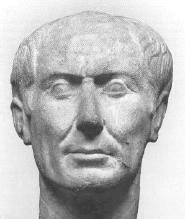 Gaius
Julius Caesar Gaius
Julius Caesar
ca. 100-44 BC.
 Julius
Caesar's War Commentaries: Julius
Caesar's War Commentaries:
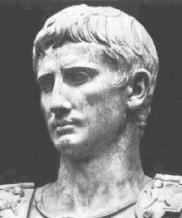 Caesar Augustus
(Gaius Octavius) (31 BC - 14 AD) Caesar Augustus
(Gaius Octavius) (31 BC - 14 AD)
63 BC - 14 AD. Emperor, 27 BC
- 14 AD.
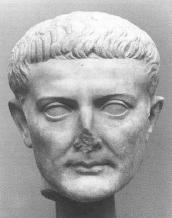 Tiberius
(14-37 AD) Tiberius
(14-37 AD)
A capable administrator – but one who
in the public view became increasingly tyrannical.
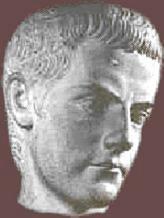 Caligula
(Gaius) (37-41 AD) Caligula
(Gaius) (37-41 AD)
A wastrel ruled by his grand lusts – which
over time turned into true insanity.
Claudius (41-54
AD)
Uncle of Caligula who basically continued
to move the Empire toward the vision that had once directed the actions
of Augustus. He strengthened the Imperial bureaucracy. He completed
the incorporation of client-states into the direct rule of the empire.
He succeeded in bringing southern Britain under Roman rule. But he
lacked polish and was the object of ridicule for his personal ways.
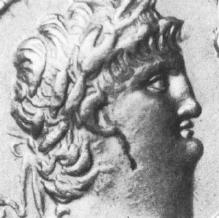
Nero
(54-68 AD)
A wild schemer whose grandiose plans
for the rebuilding of the city of Rome produced incredible tragedy, including
the burning of sections of Rome – which he blamed on the Christian community
(he proceeded to persecute Christians to make good his claims that they
were the ones at fault for the event).
A Period of Confusion
(68-70 AD)
When Nero died there was a rather thorough
murder of the last of the successors to the Julio-Claudian line of emperors.
This in turn produced a civil war which was decided not by Roman political
leadership but by the might of the contending Roman armies. After
a two-year struggle among a number of major contenders, Vespasian emerged
as the remaining candidate for the imperial title.
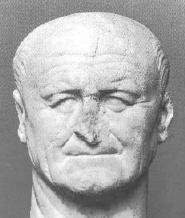 Vespasian
(70-79 AD) Vespasian
(70-79 AD)
9-79 AD. Lacking any special family ties or
noble line Vespasian attempted to undergird his hold over the principate
by assuming for himself the title of Caesar. Thus the term
Caesar
now referred not to the Italian family that had once ruled the Roman principate – but
was transformed during Vespasian's rule into a political title or office.
Caesar
now was a title of special imperial authority.
His rule was further undergirded
by strengthening the move started under Augustus to recommend to the Romans
(especially those with Eastern roots where emperor-worship had a natural
history) special reverence for the imperial caesar – to view the
princeps as a ruler with special sacred authority within the empire.
The last year of his rule marked
the beginning of the conquest of northern Britain (under General Agricola):
78-84.
Titus (79-81)
Son of Vespasian. Famed
for his conquest of Judea and the destruction of the Jewish temple there
in AD 70 – during his father's reign.
Domitian (81-96
AD)
Second son of Vespasian. He was
considered by the Senate a true tyrant. Murdered. End of the
brief Vespasian line of emperors.
Nerva (96-98)

Trajan
(98-117)
He conquered Dacia across the Danube
in modern Transylvania (Romania) bringing it under direct rule in the Empire
in 106. Active in Syria and Palestine – and the Arabian desert to
the East of both. He extended Roman rule to portions of Parthia,
creating the provinces of Armenia, Mesopotamia and Assyria. This
was the furthest extent that the Roman empire would reach – before its territorial
decline.
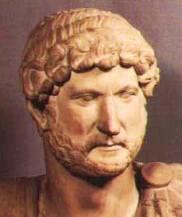
Hadrian
(117-138)
Hadrian gave up much of Trajan's territorial
gains, including the new provinces in Asia. He focused Roman efforts
instead on consolidating the Roman empire. He built a series of walls
and fortifications delimiting (the limes) the Empire. This
marked the end of Roman expansion and the beginning of the defense
of the Roman empire.
Antoninus Pius
(138-161)
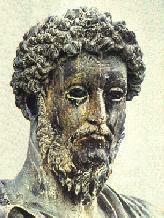 Marcus
Aurelius (161-180) Marcus
Aurelius (161-180)
 Marcus
Aurelius' major works or writings:
Meditations
(167 AD) Marcus
Aurelius' major works or writings:
Meditations
(167 AD)
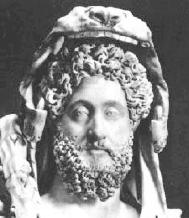
Commodus
(180-192)
Son of Marcus Aurelius. A vain
emperor who fancied himself something of a gladiator and a warrior (leading
the slaughter of helpless animals in Roman arenas and fighting gladiators
who were willing to play along with his charade as long as no one got seriously
hurt). He allowed the imperial office to degenerate into a weak institution
which offered the empire no direction or inspiration.
Another Period
of Confusion (192-193)
Pertinax (126-193) was chosen emperor
but was murdered soon thereafter by the Praetorian guard. They in
turn offered the imperial position to Didius Julian (133-193). But
he was overthrown and executed by Septimus Severus when the soldiers of
the latter marched on Rome and proclaimed him emperor in 193.
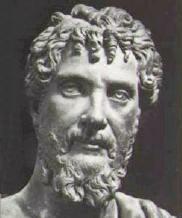
Septimus
Severus (193-211)
146-211. Begins the period of
rule by soldier-emperors – in which the imperial title is determined by
a power struggle among Roman generals and their armies. He was the
most able of the lot. He did not seek confirmation of his rule from
the Senate – and in fact ignored that body during his tenure. The
Roman army was devoted entirely to himself and his family. But constantly
challenged by contenders, draining off Roman energies in power struggles
for the imperial position.
Caracalla (Antoninus)
(211-217)
188-217. Oldest son of Septimus
Severus. He murdered his brother Geta in order to secure the imperial
title in 211. The following year he moves to widen the support of
his rule by extending Roman citizenship to most of the free people living
within the Empire.
Elagabalus (or
Heliogabalus) (218-222)
His brief rule ended when he was murdered
by the Praetorian Guard. Indeed he never really succeeded in establishing
his complete rule at any time during his own reign – there being a number
of other quite autonomous claimants to the imperial throne during that
time.
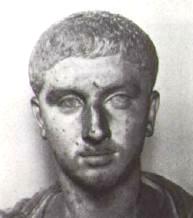
Alexander
Severus (222-235)
Alexander was another son of Septimus
who actually attempted to restore the powers of the Senate. But his
own rule was marked by a weakness which undermined his reforms.
Maximinus Thrax
(235-238)
A Thracian peasant who was brought to
the imperial position by the military. He reversed Alexander's reforms
and restored military rule as the underpinning of the emperorship.
Marks the beginning of a period of decline of the Roman empire as contenders
to the throne vied in combat with each other. This permitted the
Allamanni and Franks to cross beyond the limes of the empire (along the
Rhine) in 236. In 237 the Goths crossed the Danube into the
Balkans at the other end of the Roman line of defence against the Germans.
Yet Another Lengthy Period
of Confusion (238-253)
The confusion of competing would-be
emperors backed by their own armies which started during the reign of Maximinus
only increased in the period after him. During the next 15 years
emperors came and went in rapid succession – with more than one figure claiming
that title at the same time.
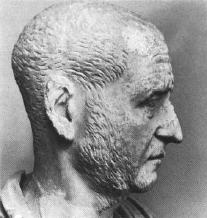
Decius
(249-251)
201-251. Decius was one of those
short-lived imperial figures. He was a major persecutor of the Christians.
He ordered a general sacrifice to the emperor to be conducted around the
empire – and for those refusing to do so to be dealt with harshly.
Decius was killed in a battle to
stop the flow of the Goths – who were crossing the Danube at will.
Valerian (253-260)
193-260. He also ordered a massive round
of persecution of Christians.
As the Romans were pushed to the
defensive against the German onslaught against the Empire in the North,
the Persians were undergoing a revival of power under the new Sassanid
dynasty and began to pose a major threat to Roman power in the East.
The Sassanids laid claim to all the Asian provinces of Rome, and attacked
Antioch. In 259, Valerian, trying to organize a defense, was captured
in this battle. In 260 the Persians succeeded in capturing Antioch.
Valerian died in captivity in that same year.
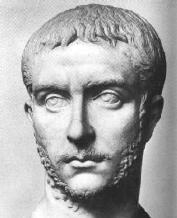
Gallienus
(260-268)
Son of Valerian. During his rule
the chaos descending on Rome reached a peak. The Roman districts
in Germany beyond the Rhine were lost, never to be recovered. A Gothic
navy of 500 ships harrassed Asia Minor and even Greece itself – sacking
Athens, Corinth and Sparta. Roman legions had to operate pretty much
on their own because of the lack of power at the Roman political center.
Cassianius Latinius Postumus (259-269)
M. Cassianius Latinius Postumus was
not an emperor but a local Roman ruler during the chaotic reign of Gallienus.
Backed by the Roman legions of Gaul, Spain and Britain, he established
a provincial empire of his own in the West (Gaul). The regionalization
of power permitted the restoration in Gaul of security from the attacks
of the invading Germans.
Odaenathus ( -266)
Not an emperor – but another regional
Roman ruler during the reign of Gallienus. As governor of the East,
he drove the Persians from Asia Minor and Syria, even recovering Mesopotamia
for Rome. He ruled – as a sovereign by his own right as Prince of
Palmyra – Syria, Arabia, Armenia, Cappadocia and Cilicia. He was murdered
in 266.
Septimia Zenobia
(266-273)
Though the rulership of Odaenathus formally
went to his young son, Vaballathus, in fact it was his wife, Septimia Zenobia,
who ruled after him. She extended her rule into Egypt – and declared
the independence of Palmyran rule from Roman authority.
Aurelian (270-275)
212-275. Aurelian restored central
Roman authority, destroying Palmyran rule in 273 and bringing Zenobia to
Rome in chains. In 274 he brought an end to the independent Gallic
empire in the West, bringing Gaul back under direct Roman rule. He
rebuilt the defenses along the Danube. He even built fortifucations
around the imperial city of Rome itself – a sign of the trouble of the times.
In 275 he was assassinated by some
of his officers.
Probus (276-282)
Defeated the Franks and Alemanni and
secured the Rhine defenses again.
Carus (282-283)
In 282 Carus restored Armenia and Mesopotamia
to Roman rule and reestablished the old boundaries of Septimus Severus.
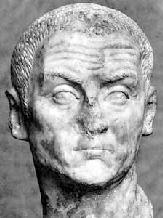 Diocletian
(284-305) Diocletian
(284-305)
235-313. Diocletian attempted
a number of reforms designed to strengthen the greatly weakened Empire.
He divided the Empire into two parts: Eastern and Western.
The Eastern part comprising Asia Minor and Egypt he himself ruled directly
from his capital in Nicomedia. The Western part comprising Italy
and Africa he assigned in 286 to Maximinian, "co-Augustus" with himself,
who was to rule from Milan.
In 293 he chose Galerius as his successor
as Caesar and Maximinian chose Constantius as his successor – freeing
themselves to their work as supreme princips or
Augusti. Thus
a quadripartite rule was established.
In 303, deeply worried about the
rising influence of the Christians in the Empire, Diocletian ordered a
major round of persecution against the Christians in his eastern territories.
This lasted through the rest of his reign – indeed until 313
In 305 both Diocletian and Maximinian
abdicated their rule, leaving power to Galerius and Constantius.
Diocletian retired to his huge villa at Salona (Split) in modern Croatia
and lived out the rest of his 8 years there.
Maximian (286-305)
Constantius I
Chlorus (305-311)
Joint rule with
Galerius : 305-311
Galerius (305-311)
Joint rule with
Constantius I Chlorus: 305-311.
Licinius (308-324)
Licinius was an Illyrian peasant who
rose through the ranks of the Roman Army – and in 308 was named "Augustus"
(junior ruler) by Galerius. In 311, with the death of Galerius, he
received Galerius's political holdings in the West. Two years later
he defeated in battle the Emperor of the East, Maximinius, and took his
holdings.
But Constantine had also been building
his strength as "Augustus" and despite their earlier friendship (Licinius
was even married to Constantine's half-sister Constantia) Constantine forced
Licinius to give up lands to him. Finally in 324 the two met in battle
and Licinius was stripped of his powers. The following year he was
executed on charges of conspiring against Constantine.
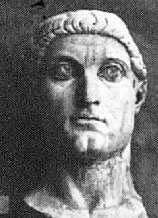 Constantine
the Great (311-337) Constantine
the Great (311-337)
273-337. Constantine was a Roman
Emperor ruling jointly with Licinius from 311 to 324 and solely thereafter
until his death in 336.
We remember him most importantly
for his conversion to Christianity in 312, which opened the way for the
adoption of Christianity as the official religion of Rome, and for his
establishing in 330 a new Roman capital in the East at Byzantium, just
across from Asia Minor.
He was originally a worshipper of
the Unconquered Sun, a widely popular religion in that time. Interestingly,
even as Constantine came to honor Christ, he retained loyalty to this god,
even establishing the first day of the week as the holy day: "Sun" day.
His conversion to Christianity came
in 312 at the Battle of Milvian Bridge – through a series of miracles and
vows which brought him to faith in Jesus Christ.
Within six months of his conversion
he was asked by the Donatists in North Africa to intervene in their dispute
with "apostate" bishops (ones who had at one point denied their faith under
the pressure of persecution) whose authority the Donatists no longer recognized.
Constantine did intervene – but found in favor of the restored bishops against
the Donatists, and ordered the Donatists to submit to the authority of
these bishops.
He went from there to become increasingly
active in imposing "order" on his new church – seeing this as his imperial
duty to God (as always had been the understanding of the Emperor's responsibility
to the empire: that is, to be the "defender of the faith").
He was responsible for calling the
Council of Nicea (325) to decide the dispute between Alexander, Bishop
of Alexandria and his presbyter, Arius – who had come to espouse a monarchian
or "unitarian" position. The Council itself decided in favor of Alexander – and
outlined the basics of the "Nicene Creed," which stood at the heart of
"Trinitarian" Catholic doctrine.
Though Constantine stood firmly behind
the Council and its decision, he himself remained quite tolerant of the
unitarian Arians – who were widely popular in the East (where the Nicene
"Trinitarian" decision itself was unpopular). Rumors were that he
himself had Arian sympathies – but kept them to himself in order to preserve
the religious unity of his domain.
Triumvirate of
Constantine II, Constantius II and Constans (336-350)
Upon Constantine's death in 337 the
empire was divided up among his three sons. They intrigued and fought against
each other – and others – until in 354 Constantius held position as sole
Roman emperor.
Constantius II
(354-361)
Constantius was a fervent Arian and
intimidated the bishops into an anti-Nicene position. At the same time,
pursuing religious conformity within his empire, he pushed the Christian
cause against paganism more forcefully than his father had – closing the
temples in 356 and removing the alter of Victory from the Roman Senate
in 357.
Julian (361-363)
Called the "Apostate" for his efforts
to end Christianity's religious monopoly and restore pagan worship to prominence
in Rome – even though he himself was raised in his youth as a Christian.
Julian was a nephew of Constantine
who had miraculously escaped the murderous intrigues that took the life
of most of the rest of his family in 337. Upon finally becoming emperor
himself, he disclosed his pagan loyalties and began to try to undo the
work of his Christian uncle Constantine and cousin Constantius. He
tried to substitute a new religion based on Platonism in which the Supreme
Being was identified with the Sun God Helios (akin to the popular Mithras).
He tried also to establish the same moral rigor for his faith that made
Christianity so respectable – and even copied the ecclesiastical organization
of the Christian church.
He did not directly persecute Christianity
but did remove Christianity's privileged position within the government
and forbade Christians from teaching in the public schools (in an effort
to bring the empire back to its pre-Christian traditions through the children).
But there was no real zeal among the populace for his reforms – which became
quickly apparent soon after he took over. This really closed the
book for traditional paganism.
Jovian (364-365)
Valentinian I
(West 364-375)
Western Roman Emperor
Valens (East 364-378)
Eastern Roman Emperor – brother of Valentinian
I.
In 370 Huns poured into Eastern Europe
from Asia, pressing the German-speaking Goths who inhabited the area. Emperor
Valens permitted the Goths (Visigoths or Western Goths) to settle inside
of traditional Roman lands, hoping that they would serve as a buffer to
the Huns. But soon both the Visigoths and their close kinsmen the Ostrogoths
(Eastern Goths) joined forces to defeat the Eastern Roman armies – establishing
Gothic autonomy within the Roman Empire. Eventually many of them were brought
into the Roman army in the hope that they would add vigor to the declining
Roman military power.
Gratian (West
jointly 375-383)
Joint Western Emperor (367-375)
with his father Valentinian until the latter's death in 375 and then with
his 4-year old brother Valentinian II.
The Empire was under constant attack
from Germanic tribes and he spent his rule mostly in Gaul fighting off
the Goths.
In 383 he marched his army against
the usurper of Roman power in Britain, Magnus Maximus. But his tooops
deserted him and he was murdered during his attempt to escape.
Valentinian
II (West jointly 375-383; solely 383-392)
Emperor of the West: jointly with
Gratian from 375 to 383 and solely thereafter until 392.
Theodosius I (East
379-392; East and West 392-395)
346?-395. Eastern Roman Emperor
from 379 to 392. After 392 until 395 he ruled both East and West.
He called the Christian Council of Constantinople.
Symmachus (345-410)
Quintus Aurelius Symmachus was not a
Roman Emperor – but was however a strong voice of the old pagan viewpoint
in the Roman Senate. His life of public service, his sterling moral
character and his wealth and personal influence made him an outstanding
spokesmen against the Christian ascendancy in Rome. In 382 he was
expelled from Rome after his strong protest over the removal of the statue
and altar to Victory in the Senate chamber. He was restored to influence
soon thereafter (prefect of the city of Rome), but proved to be still as
adamant as ever over this issue, appealing to to Emperor Valentinian to
restore these symbols of traditional Rome.
Stilicho (394-408)
Flavius Stilicho was not a Roman emperor – but
a mighty political force in the Empire that at times exceeded in power
the position of the Western Emperor.
He was born to a German Vandal officer
in the Roman army of emperor Valens. Stilicho himself joined the
imperial army and rose quickly up the ranks. In 383 he was sent by
Emperor Theodosius as a diplomatic envoy to the Persian King Sapor.
On his successful return he was brought into the imperial family by marrying
the Emperor's niece/adopted daughter, Serena.
In 385 he began a very successful
military career: in Thrace against the Goths, in Britain against
the Picts, Scots and Saxons, and along the German Rhine.
In 394, with his wife Serena, he
was appointed regent over the youthful joint emperor, Honorius – bringing
Stilicho into the thick of imperial politics. His main rival to his
deep political ambitions was Rufinus. In order to bring him down
Stilicho marched his army to the east to meet Rufinus, but then had Rufinus
assassinated. This made Stilicho the virtual dictator of the Roman
Empire.
In 396 he was drawn into Greece to
fight Alaric and the Visigoths – but
worked out a diplomatic settlement with Alaric instead.
By the year 400 he was consul – and
also father-in-law to Honorius.
In 401-402 he was called to action
again against Alaric (and Alaric's ally Radagaisus) – this time along the
Danube and in Italy. Once again he was successful in delivering the
Empire from this Barbarian threat through military victory and diplomatic
settlement. But in 405 Radagaisus again invaded Italy. This
time Stilicho starved Radagaisus to defeat.
In 408 Stilicho began to strengthen
his hold over Honorius with the marriage of his second daughter to the
Emperor. But then he was accused of plotting to overthrow his son-in-law
in order to establish himself as Emperor. Whatever the truth of the
matter, Stilicho fled to Italy, taking sanctuary in Ravenna. He was
brought out by a promise of safe-conduct – but was seized and executed nonetheless.
Honorius (394-423)
Emperor of the West, whose political
fortunes during the first 14 years of his rule were closely tied to Stilicho.
Arcadius (395-408)
c. 377-408. Emperor of the East, brother
of Honorius. It was during his reign that Alaric
invaded Greece.
Theodosius II
(East 408-450)
Valentinian
III (West 423-455)
| 


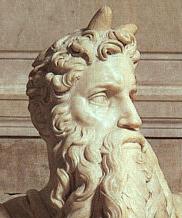 Moses
Moses
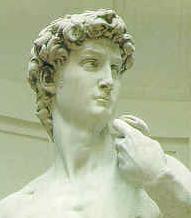 David
David
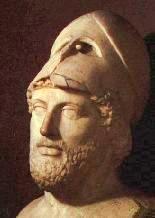 Pericles
(490-429 BC)
Pericles
(490-429 BC)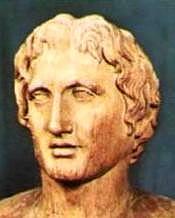 Alexander
III (the Great) of Macedonia (356-323 BC)
Alexander
III (the Great) of Macedonia (356-323 BC)
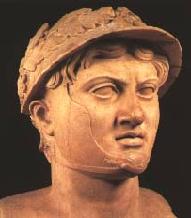 King
Pyrrhus of Epirus
King
Pyrrhus of Epirus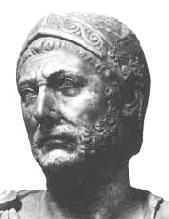 Hannibal
Barca ( -182 BC)
Hannibal
Barca ( -182 BC)
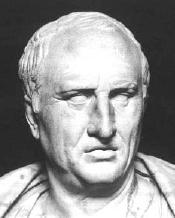 Marcus
Tullius Cicero
Marcus
Tullius Cicero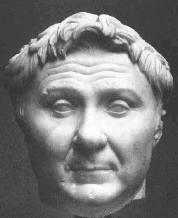 Pompey
(82-54 BC)
Pompey
(82-54 BC) Gaius
Julius Caesar
Gaius
Julius Caesar Caesar Augustus
(Gaius Octavius) (31 BC - 14 AD)
Caesar Augustus
(Gaius Octavius) (31 BC - 14 AD)


 Vespasian
(70-79 AD)
Vespasian
(70-79 AD)







 Diocletian
(284-305)
Diocletian
(284-305) Constantine
the Great (311-337)
Constantine
the Great (311-337)

